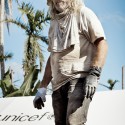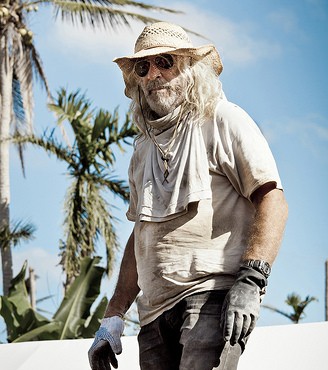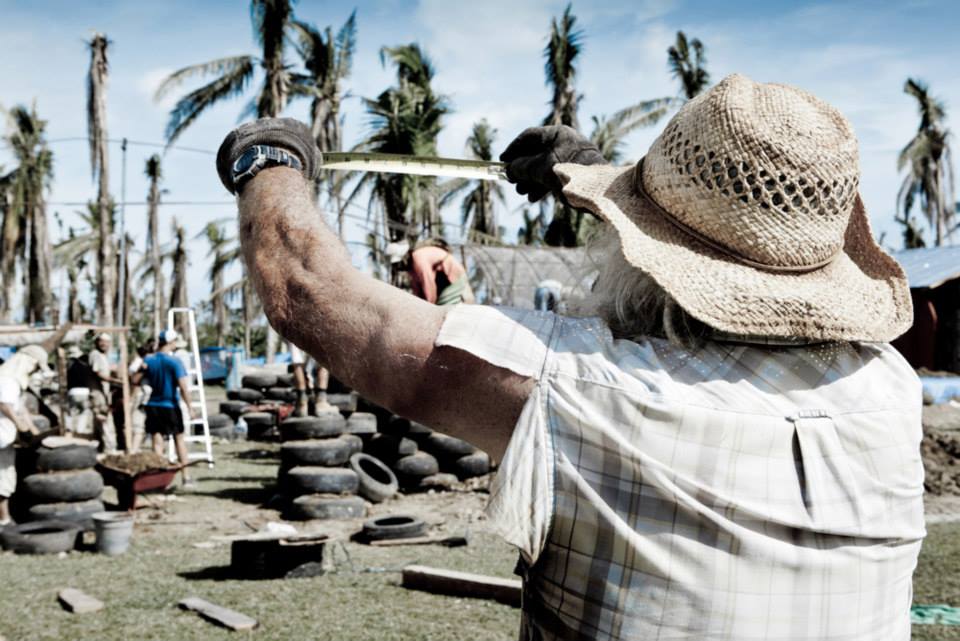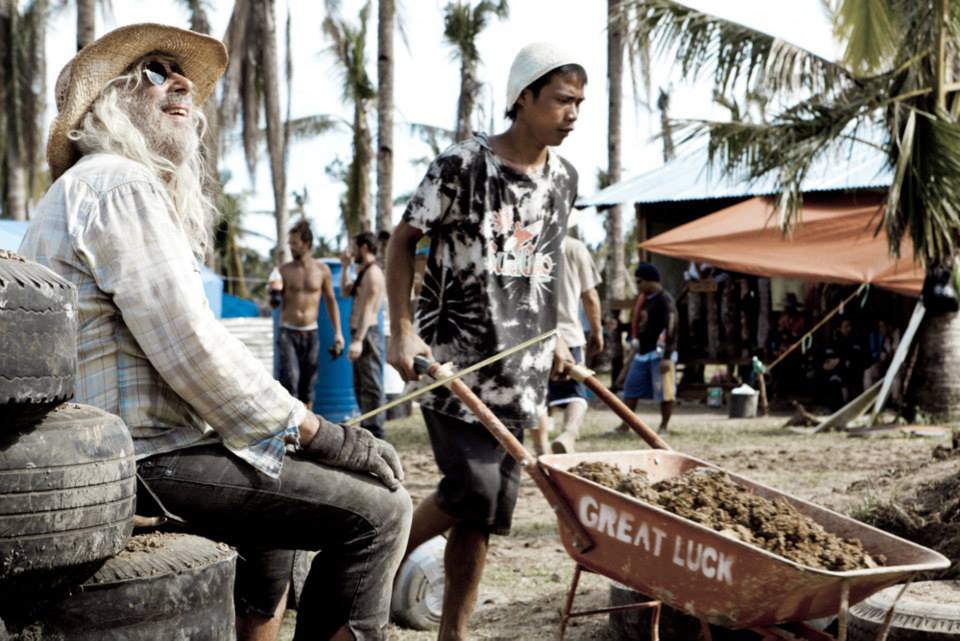Michael Reynolds:
Earthship Biotecture is sort of like a virus. It starts growing a little bit in some place. It may be squelched due to codes and regulations but it comes right back. It’s kind of happening everywhere. We’re all over the world all the time now. I’m going from here to Alberta and then to Easter Island. It’s everywhere.
Alessandro Turci, Italy:
You were also in Malawi. Could you please explain the main differences between the Malawi project and this one?
Michael Reynolds:
Malawi was what we called a flower. It was a bunch of these rooms all radiating around a middle like flower petals, and the middle was the water catchment systems. The reason we didn’t do that here is because of the wind. This was aimed at primarily being a storm shelter, a building that would not be blown away in a typhoon. Everything else was secondary to that.
Yes, it’s gonna make its own electricity and cool itself and treat its own sewage and harvest its own water and use recycled materials, but the primary thing was that it not be something that that gets blown away. They rebuild every time there’s a typhoon. Everything just blows away. The idea here was to make it not be a building that would be damaged in a typhoon. That’s the main reason the rooms face each other. It’s like a fort.
When you see this scaffolding gone and buried all the way around with two big gateways out from those doors, those arches, they will be closed and the storm would be up there in the sky. It wouldn’t make it into this protected area. This is semi-protected here and it’s totally protected in there. The design of this was aimed at not being destroyed in a typhoon.
Alessandro Turci:
You put down a drawing just after the disaster on the internet. How was this idea born?
Michael Reynolds:
We’ve been doing this all over the world for decades. Then after the typhoon, I said, well, these buildings that we have been building are already half typhoon-proof because they’re buried on three sides so I said why don’t we just make two of them facing each other.
We’ve had that experience before in high winds, these [Earthships] you don’t even notice the wind’s blowing. And so we just took a standard design and faced it off against another standard design. We’re making a fortress against the wind. It’s a building that we’ve built many times, but we just faced two of them together rather than making them face the sun which is what we do in a cold climate.
Alessandro Turci:
This one will have botanical cells and so on, light, equipment of the standard…
Michael Reynolds:
Yeah, it’ll have sewage treatment that uses the botanical cell method so no sewage will leave into the ground or anything. It’ll all be used and re-used.
Jon Gosch, Seattle, USA:
Talking to Phil [Basehart], he was saying that one of the big issues of being able to replicate this many times over is, of course, funding. How do you see a strategy going forward to get more funding? What would that take? Who could you look to?
Michael Reynolds:
Well, we didn’t have any funding. When we went to the Indian Andaman Islands I went to my bank and borrowed fifty grand. That was after the tsunami. And in Haiti we did a little fundraiser, but now we’ve gotten to the point where lots of people around the world want to work with us and learn and so we charge them a tuition and their tuition buys the materials and it buys our plane tickets.
We’re funded by the people that come out here and slave in the hot sun and help us. Everybody here not only is building this building but they funded this building. Rather than waiting around for a Bill Gates or Oprah Winfrey or somebody like that to donate money and then get a bunch of credit for it or whatever.
This method is all about people. People are funding it. When I heard about the typhoon in the Philippines I sat at my kitchen table and made a sketch and then got it up on our website and money started coming in. I just said is there anybody interested in helping us do this and people started saying, yes I am, yes I am. Three hundred people said it and we can only take forty or fifty.
The whole thing because of the knowledge that’s transferred and the concepts that are being explored is funding itself now. We can go anywhere we want. We just pick the next place and set it up. Takes three or four months to raise the money and get the design together and go do it.
Jon Gosch:
A big part of this project is transferring the knowledge to the locals and I’m wondering in previous projects have you seen that they’ve continued to replicate and live within it?
Michael Reynolds:
One in particular was that we did a school in Sierra Leone. It had eight rooms like flower petals around a center of water. We only had money and time to do two of the flower petals. We worked really hard with about ten of them shadowing us and we left and it was six months later but they sent us the picture and it was all done. So we know that it’s possible.
We’re always trying to make the design easier. Easier in using more indigenous materials to the area. So we are constantly evolving it, but we are starting to have success at having people replicate and I think that’s the idea.
Natalie Davenport, Australia:
Another wave of volunteers are going to come over that’ll be completing the botanical cells, the graywater, the shower, bathroom, all this. And then following that you’d like to see another wave of volunteers to build a home-size earthship…
Michael Reynolds:
Home type. Yeah. That’s using less cement and rebar and more palm trees and bamboo. And I think we can do it. As a matter of fact, what I might do… We’re gonna leave Jemuel and a few people here to keep going a little bit, but I think I’ll organize the next ten day hit to be a team for doing the systems and the botanical cells and everything and then a few people to do the home. The home with the palm trees and the bamboo.
It’s a similar concept, but you can cut the trees here. You can cut the bamboo here. You can gather the tires here. You’re talking a thousand dollars in materials, maybe. We just didn’t want to do that for a storm shelter for a school. When they told us it was going to be a storm shelter for a school we shifted into another gear. But for the people, that would be the thing.
Natalie Davenport:
Because that’s their question that’s being asked, like I said before, is how in an environment like this where concrete and rebar is quite expensive, do local people come up with those types of materials? So it’s about them adapting the design or coming in with a home style type of design where they can see, oh yeah, we can do that, we can apply that and build these ourselves without too much expense.
Michael Reynolds:
And I think if we show that, I think we have a chance of that working. Cause I’m looking at what they’re building with. They’re building with the palm trees cut up into lumber and they’re using nails and screw and tin. So they have tires here. They’re free. And they have the palm trees. We can use them. They have bamboo. And that’s all they would need. So they could just have a much more substantial shelter that they built themselves.
Natalie Davenport:
Okay. And so if people want to donate to earthship and contribute to this cause, whether they want to come over as a volunteer or if they just want to donate financially to help with materials and stuff, who should they contact, and what’s the best way to go about doing that?
Michael Reynolds:
Our website, earthship.com, has all of our current projects and you click on Philippines if you want to get involved or donate to the Philippines and it has a button where you can go to Paypal and make a Paypal donation.
We’re still getting donations for Malawi for materials and getting donations for the Philippines. We’re still getting donations for Haiti. You know, people send five dollars, ten dollars, and then some people send a hundred dollars and say, use it for whichever one. Cause we’re always going out there. As soon as we get money we go again.
Jon Gosch:
One more question on funding. You mentioned earlier you’re not sitting around waiting for Bill Gates which I think is wise, but is that something that you have tried? Not him specifically, but wealthy donors who might be interested?
Michael Reynolds:
I really haven’t tried that much because I figure if something’s right it’ll sell itself, you don’t have to sell it. And this is selling itself. This is selling itself to real people.
Usually there’s a stipulation. If somebody’s gonna give you a million dollars to do something they’re gonna want a certain look or a certain this or a certain that and we don’t really want to do that. We want to go and shoot from the hip and say this is the way we think it should be done and we do it. Me and Phil and Rory and Brian and we just figure it out. And we don’t want really this kind of work to be governed by some donor’s opinions.
Sure, if Bill Gates came and said I’ll give you a million dollars and do what you want with it for any of these causes, why sure we’d be fine with that. I had many years ago some people give me a hundred and fifty grand a year for three years just to develop some of these ideas and I turned it down, twice, because I didn’t want em to tell me what to do and finally they said, look, we’ll give you the money and we don’t care what you do. Just report to us what you’ve done. And I said okay.
And I really like the thing that is going on now with the… It’s not really crowd funding, it’s human equity, kinda. It’s human funding. It’s really working that way cause you’ve got people here that are invested in this building. They’ve invested a thousand dollars and ten days of busting their ass so they’ve gotta be serious and they are. That’s why it happens.
Jon Gosch:
Being from America, definitely this Windship design would be applicable to the whole eastern seaboard where they get hurricanes typically. One, do you think that that might be a place to go for another build, and two, do you think it’s going to take a disaster like Haiyan for people on the eastern seaboard to realize that they need to be designing in this way?
Michael Reynolds:
There’s so much other than just hurricanes in New York and typhoons in the Philippines. There’s a lot of climate change going on. Probably a little more than there used to be, and people are realizing that when you put that together with what we are doing for energy right now, we are making nuclear power plants and totally destroying the whole northern hemisphere.
People are starting to realize that there has got to be a better way and just a quick explanation of a better way is that each building is self-contained. That it interfaces and encounters the natural phenomena of the earth, breathing in, breathing out, just like plants, just like animals. Buildings need to do that. Rather than needing all of these utilities and infrastructure. That concept alone could change things radically. That concept could make it a lot easier to rebuild the next time on the eastern seaboard, to rebuild with something that’s gonna stand up.
In Louisiana they wanted us to rebuild there with some earthships, but they wanted it down in the flood zone. I said, I’m not gonna rebuild there cause it’s gonna be underwater anyway. No matter how well we build it it’s gonna flood out cause it’s below the levee line. So we are making logical choices. If somebody wants us to rebuild in Louisiana up on a high plateau, yes. The Windship would be great for tornado alley in the U.S. or the eastern seaboard where all the hurricanes hit. It’d be great. This design will probably get used in other places in the U.S.
Natalie Davenport:
Can you give us a quick description of an earthship in Taos?
Michael Reynolds:
In Taos it gets as much as thirty-five below zero Fahrenheit. That’s cold enough to where the inside of your nose freezes. And it gets hot just like this. And so in those two extremes when you’re in an earthship, you don’t know what it is outside. You can look out and it’s sunny or dark but you go outside and you go, oh my god, I didn’t realize it was that cold. Cause you’re in there with banana trees. There’s no fuel. I’ve seen bananas growing on the tree, looking through the banana tree at two feet of snow outside. It’s warm.
I have big thermometers at my house where I look through and see the temperature outside and then I see the temperature in the outer greenhouse and then I see the temperature in the house and the house is always comfortable without fuel of any kind. I mean, I’ll build a fire sometimes to be romantic or snuggly or whatever. But for atmosphere. I come home in late January after a few margaritas. I’ll open my door and my house embraces me with warmth. And there’s no fire burning, no heater on. It’s just amazing. And people don’t know that that’s possible.
As long as we’ve being doing it. I’ve been doing it over forty years and people still don’t know, the majority of the people on the planet don’t know that that’s possible. Certainly they don’t know that catching water from the sky is possible, treating your own sewage and not putting it into rivers and streams is possible. They just don’t know these things are possible and they really don’t know how easy they are, but things are getting bad enough that they’re starting to look for something.
Jon Gosch:
Do you think earthships are necessarily a rural type of solution or can they also be applied to dense cities like San Francisco or Seattle?
Michael Reynolds:
We are actually working on a design right now that’s made it through two council meetings in Mid-town Manhattan. These principles can be applied anywhere. It’s just that most of the time it’s been applied in rural areas, but they can be applied anywhere. It’s just the principles. It’s biology and physics. You take the biology and physics and apply it to your situation. It’s more important for us to teach the biology and the physics that makes this work than our version of how it works.
Be sure to catch the rest of the series!
- Part One: Michael Reynolds, Creator of Earthship Biotecture
- Part Two: Leo, Olav and Zoe, Windship Volunteers
- Part Three: Hui-Chien and Josh, Windship Volunteers
- Part Four: Florian Becquereau, Founder of Earthship Seattle
- Part Five: John Craig, Christina and Hendry, Windship Volunteers
- Part Six: Andrea Roa Buco, Community Activist and Native of Barangay Batug
- Part Seven: Maria Marasigan, Community Organizer and Earthship Activist



